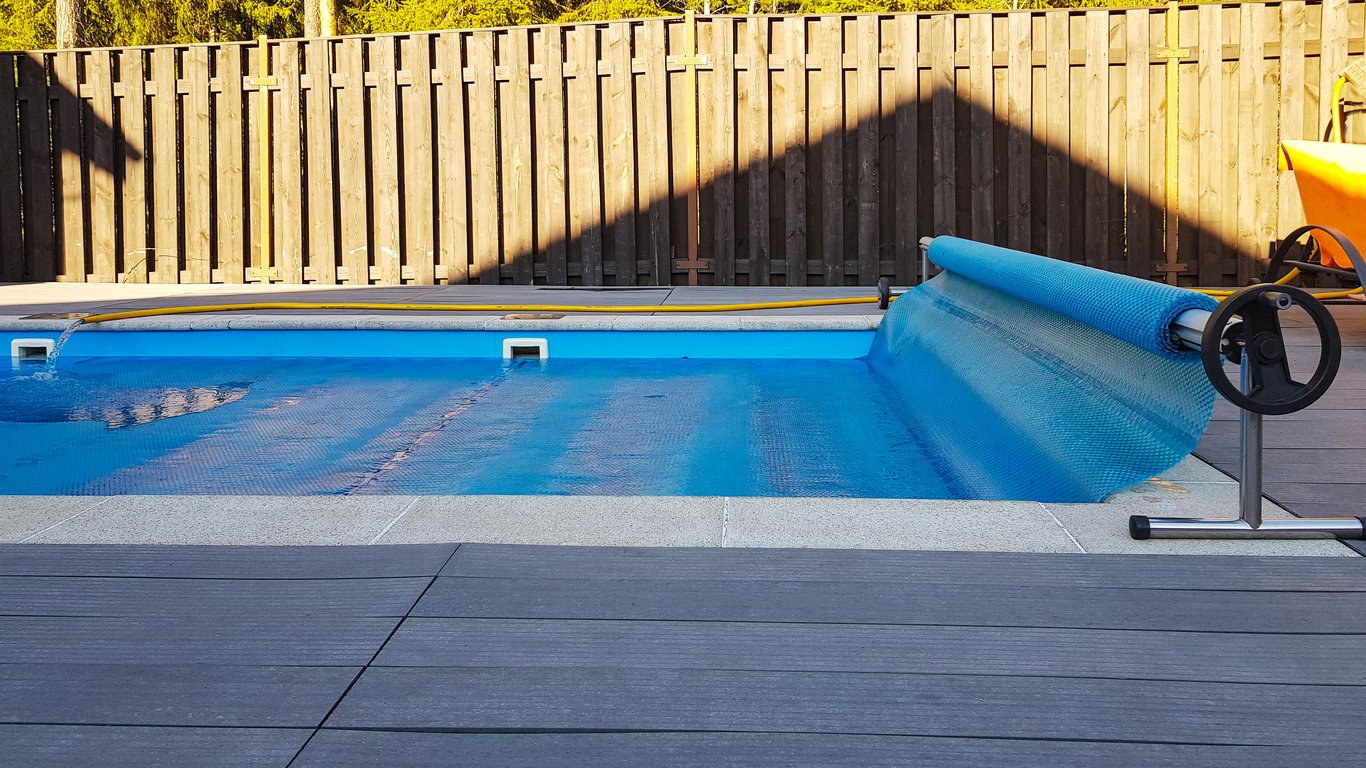
While durable, swimming pool covers in San Jose are not built to last a lifetime. However, regular maintenance guarantees their extended useful life. Even if a pool cover has a one-year service warranty, these maintenance measures will reduce your need to bring it to service for repairs too often.
Which is more prone to damage – manual or automatic pool covers?
When shopping for a new pool cover, consider how long it will last or how damage-resistant it is.
Automatic pool covers are generally more prone to damage than manual ones. Here’s why:
- Complex mechanisms: Automatic covers have motors, tracks, and electronic components that can malfunction or wear out over time. The machinery is sensitive to debris, weather elements, and occasional power surges, making repairs more frequent and often more costly.
- Exposure to elements: Automatic covers tend to stay exposed longer, which can lead to quicker deterioration from UV rays, water accumulation, or snow. It can lead to tears or stretching if the cover is not cleaned or maintained regularly.
- More moving parts: The movement of the cover back and forth can cause wear and tear on the cover material itself, especially if it is not aligned correctly or if debris blocks the track.
Manual covers, on the other hand, are simpler and typically require only basic maintenance, such as occasional cleaning and proper storage. They may not last forever but are usually easier and cheaper to repair or replace if damaged. Their durability still depends on the material’s quality and proper handling.
Of course, the more damage-prone a pool cover is, the more frequently it may need repairs, leading to additional expenses. It can also lead to increased downtime, meaning a pool cover might stay out of service longer while waiting for parts or repair appointments, potentially leaving your pool exposed.
Pool cover maintenance tips
Maintaining your pool cover properly helps prevent damage and prolongs its life. It also saves you on repair costs. Here is a comprehensive guide on effective pool cover maintenance to help you get the most from this essential pool accessory:
1. Regular cleaning
- Debris removal: Remove leaves, branches, and dirt regularly. Heavy buildup can weigh down the cover, leading to tears or stretching, especially with mesh covers. Use a soft broom or a leaf blower to gently remove debris without damaging the material.
- Weekly cleaning: Even if there isn’t visible debris, it’s best to give the cover a quick brush-off weekly, especially during fall when leaves are more likely to accumulate.
- Seasonal deep cleaning: Clean your cover thoroughly at the start and end of each swimming season. Use a gentle pool cover cleaner, as harsh chemicals can weaken the material, and avoid scrubbing aggressively. Rinse thoroughly to remove any cleaner residue.
2. Water drainage for solid covers
- Avoid excessive weight: Rainwater and snow can accumulate, adding more weight to solid pool covers, which may cause tearing or stress on the anchoring systems. To prevent this, use a cover pump to remove water after a storm.
- Snow removal: For areas with heavy snowfall, clear the snow with a soft broom rather than a shovel to prevent tears. Snow melt can also contribute to weight, so consider a submersible cover pump during the winter.
3. Checking for pool cover tension
- Adjust tension regularly: Too-loose covers can sag, causing stress on the anchors, while too-tight covers are more susceptible to wear and tear. Check and adjust the tension monthly, especially during seasons with heavy wind.
- Inspect for anchor stability: If you’re using anchors, ensure they’re stable and holding the cover securely. Weak or loose anchors can cause the cover to shift or come undone, especially during heavy winds.
4. Maintaining pool cover hardware
- Regularly check components: Inspect all fasteners, springs, and straps. Replace any worn parts promptly, which may cause cover sagging or detachment.
- Lubricate moving parts: Hinges and retractable mechanisms benefit from periodic lubrication with a non-corrosive lubricant. Doing so reduces friction, prevents rust, and extends the life of moving components.
- Cleaning and replacing anchors: If your pool cover uses anchors embedded in concrete, clean around them to avoid dirt buildup that could weaken the hold. If any anchors appear damaged, replace them to prevent cover detachment.
5. Avoid direct sun exposure
- Protection from UV rays: Constant exposure to the sun can weaken pool cover materials over time, especially for vinyl or mesh covers. If your pool is not in use for extended periods, consider storing the cover or using a protective tarp over it to block UV rays.
6. Proper storage during off-seasons (for manual pool covers)
- Dry completely before storage: If the cover is stored while damp, mold and mildew can form, potentially weakening the material and causing unpleasant odors. Lay the cover out in the sun to dry before storing it.
- Use a cover storage bag: When unused, store your pool cover in a durable, waterproof bag. This helps protect it from dust, insects, and rodents, which can damage it.
- Choose a cool, dry place for storage: Heat and humidity can accelerate material degradation, especially for vinyl covers. Store the cover in a well-ventilated area to keep it cool and dry.
7. Regular inspections
- Monthly inspections: Inspect your pool cover monthly to catch minor issues, such as small tears, that could become bigger if ignored.
- Check for mold or mildew: If you notice any signs of mold, clean the affected area with a gentle solution of water and vinegar. Rinse thoroughly and allow the cover to dry completely.
8. Preventing and repairing minor damages promptly
- Addressing small tears immediately: Minor tears are much easier to repair than larger rips. Use a vinyl or mesh repair kit when you notice a small tear to prevent it from expanding.
- Professional repairs for larger issues: If the cover has significant damage or multiple tears, consider taking it to a professional for repairs. Attempting DIY fixes on extensive damage may reduce the cover’s lifespan.
9. Protecting your cover during pool maintenance
- Avoid chemicals on the cover: When adding chemicals to your pool, keep the cover off until they’re fully dissolved and circulated. Doing so prevents chemical exposure that can weaken the cover material, especially in vinyl or plastic types.
- Limit Sharp or abrasive tools near the cover: Be cautious when using pool maintenance tools like skimmers or brushes near the cover, as sharp edges can cause tears or punctures.
10. Invest in a quality cover for long-term savings
- Consider a Durable, higher-quality cover: If you frequently encounter issues with your pool cover, it may be worth investing in a sturdier model with additional weather-resistant or UV-protective properties. High-quality covers can offer better durability and lower long-term maintenance costs.
Parting words
Regular maintenance on your swimming pool covers in San Jose helps avoid the costly cycle of repairs and replacements while keeping your pool cleaner and more protected. Well-cared-for covers can often last many years, saving time and expense in the long run.
For professional maintenance tips or assistance in new pool cover installation, contact Pool Covers, Inc. at 707-864-6674 or customerservice@poolcoversinc.com.










